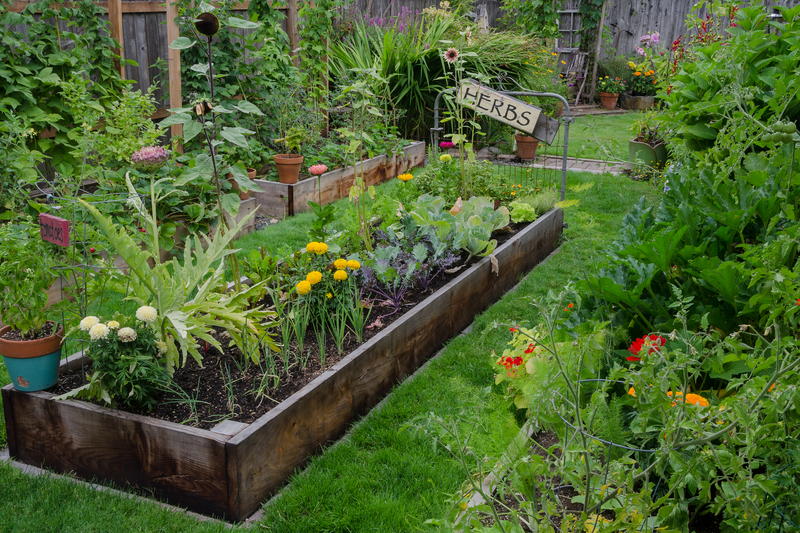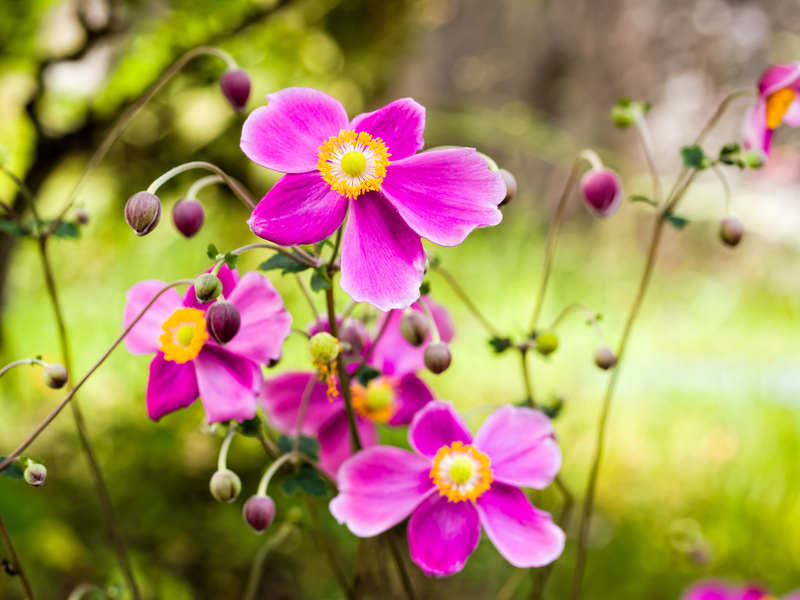Initiate the Revival of Your Neglected Botanical Haven
Posted on 26/08/2025
Initiate the Revival of Your Neglected Botanical Haven
Is your once-thriving garden showing signs of neglect? Don't worry--it's never too late to restore your forgotten oasis. Initiating the revival of your neglected botanical haven can be an immensely rewarding project, delivering beauty, biodiversity, and a sense of accomplishment. This comprehensive guide will help you transform your overgrown, listless garden into a vibrant sanctuary, teeming with life and color.
Understanding the Importance of Botanical Haven Revival
A neglected garden is more than just an eyesore; it can become a breeding ground for pests, invasive species, and disease. But with the right strategy and persistent effort, you can time-travel your landscape back to its former glory--or even surpass it! Rejuvenating your garden supports local pollinators, improves air quality, and boosts your property's curb appeal.

Assessing the Current State of Your Overgrown Garden
Before you roll up your sleeves, invest time in examining your space. Consider these elements:
- Plant Health: Identify any surviving plants and assess their vitality.
- Soil Quality: Check for compaction, erosion, or visible nutrient deficiencies.
- Pest and Disease Presence: Look for signs of infestations or plant illnesses.
- Watering System: Evaluate your irrigation setup for leaks or blockages.
- Sun and Shade Patterns: Note how much sunlight reaches different areas throughout the day.
Create a restoration notebook to track your observations. Photographs and written notes will prove invaluable as you progress in your garden's revival journey.
Building a Botanical Revival Plan
Step 1: Set Garden Goals
Ask yourself: What is your vision for this garden? Your ambitions will shape your plan. Do you want a wildflower meadow, a serene Zen retreat, or a productivity-packed vegetable plot? Setting clear goals gives you direction and motivation as you initiate the revival of your abandoned green space.
Step 2: Remove Debris and Tame Overgrowth
The first tangible step is clearing your garden canvas. Start by:
- Raking leaves, fallen branches, and other debris.
- Pulling out dead annuals, invasive weeds, and any plants beyond saving.
- Pruning overgrown shrubs and trees--but avoid heavy pruning in peak summer heat or dormant winter, as this can stress the plants.
- Sorting healthy perennials from those that need to be replaced.
Keep compostable materials separated so you can recycling nutrients back into your garden beds later.
Step 3: Revitalize the Soil
Years of neglect often leave soil compacted and depleted. The foundation of any successful botanical garden revival is robust, fertile earth. Revitalize your soil by:
- Testing for pH and nutrients. Home test kits or professional services provide invaluable data.
- Amending with organic matter, such as compost, well-rotted manure, or leaf mold.
- Aerating compacted areas with a garden fork or aeration tool.
- Mulching to retain moisture and reduce weed competition.
Selecting the Right Plants for a Lasting Botanical Revival
Successful plant selection ensures your restored garden thrives. Choose:
- Native species suited to your climate and soil--these require less water, fertilizer, and maintenance.
- Resilient varieties that tolerate periods of neglect or harsh conditions.
- Pollinator-friendly flowers to attract bees, butterflies, and birds for a vibrant ecosystem.
- Structural plants such as ornamental grasses or small shrubs, offering year-round appeal.
Group plants with similar water and light requirements together--an approach known as hydrozoning--to simplify care and maximize beauty.
Planning and Installing Effective Irrigation
Water is life. Revive your garden's irrigation by:
- Inspecting and repairing old hoses, drip lines, or sprinklers.
- Adding soaker hoses or drip irrigation for efficiency in flower beds and vegetable plots.
- Watering deeply but less frequently to encourage deep root growth.
- Installing rain barrels to harvest water and reduce costs.
A well-hydrated garden bounces back faster, sustaining your newly planted botanical haven.
Combatting Weeds and Pests in a Restored Green Space
An abandoned botanical garden often harbors stubborn pests and invasive weeds. Tackle these with a strategy that favors ecology over chemicals for long-term health:
- Hand-pulling weeds when soil is moist, removing entire roots.
- Sheet mulching: Smothering weed-prone areas with cardboard and a thick layer of mulch to deprive weeds of light.
- Encouraging natural predators such as ladybugs and birds to keep harmful insects in check.
- Planting companion species to repel pests or attract helpful pollinators.
If necessary, use organic pesticides, but sparingly and targeted--never as a cure-all.
Design and Aesthetic Considerations for Your Botanical Sanctuary Revival
Don't just restore--reimagine! When you initiate the restoration of your neglected oasis, consider ways to blend function with beauty:
- Add permanent paths and stepping stones for access and definition.
- Install decorative elements like benches, sculptures, or birdbaths.
- Mix heights, colors, and textures to create visual intrigue year-round.
- Include a water feature for sound, motion, and wildlife attraction.
- Light up the space with solar-powered fixtures for nighttime delight.
Your revived botanical haven should be as inviting to you as it is to wildlife, providing relaxation and inspiration in equal measure.
Maintaining Momentum: Building Healthy Garden Habits
The biggest secret to a lasting gardenscape revival is consistency. Develop habits that keep your sanctuary on track and prevent future neglect:
- Set a regular schedule for weeding, watering, and pruning.
- Keep a Garden Journal to note what works and what needs adjustment.
- Mulch annually to suppress weeds and lock in nutrients.
- Scout for pests and diseases early to nip problems in the bud.
- Rotate crops in edible plots to discourage soil-borne pathogens.
Even 15 minutes of weekly care can make all the difference.
Embracing Biodiversity and Sustainability in Your Revitalized Botanical Sanctuary
As you initiate the revival of your neglected botanical haven, use the opportunity to:
- Plant native wildflowers for pollinators.
- Create a bee hotel or butterfly habitat.
- Install a compost bin to recycle garden and kitchen waste.
- Use rainwater and organic fertilizers for lower impact gardening.
- Leave a patch "wild" for beneficial insects and ground-nesting bees.
These sustainable practices result in a healthier, more resilient garden ecosystem that rewards you for years to come.
Overcoming Common Challenges in Botanical Restoration
Revitalizing a long-abandoned garden is not without hurdles. Here's how to handle some of the most common issues:
Poor Soil Structure
- Double-dig beds and incorporate compost or worm castings.
- Use cover crops over the winter to rebuild fertility and structure.
Persistent Weeds
- Smother with layers of newspaper, cardboard, and mulch.
- Replant dense ground covers to outcompete troublemakers.
Pest Infestations
- Encourage predatory insects and birds.
- Use floating row covers over vegetables.
Lack of Time
- Start small--focus your efforts on a single bed or border at first.
- Recruit family and friends for volunteer days.
Don't be discouraged by setbacks. With persistence, your restored botanical sanctuary will flourish.
The Joys and Rewards of Reviving Your Garden Sanctuary
As your neglected botanical refuge springs back to life, you'll enjoy more than just an attractive view. Gardening is proven to reduce stress, improve mental health, and enhance physical well-being. A revitalized garden also offers:
- Fresh, home-grown fruits, herbs, and vegetables.
- Greater biodiversity--including butterflies, songbirds, and beneficial insects.
- Seasonal interest and color for curb appeal.
- A peaceful retreat to unwind from the modern world.
- Opportunities for creative expression through landscape design.
Invite friends and neighbors to share in the bounty. A reborn botanical haven can quickly become the heart of your home and neighborhood.

Creative Inspiration: Design Ideas for Your Botanical Renewal
- Pollinator Borders: Plant swathes of coneflowers, salvia, and milkweed for a butterfly and bee buffet.
- Herb Spirals: Gain culinary delights and vertical interest with a spiral of rosemary, thyme, and basil.
- Wildlife Watering Stations: Add shallow dishes of water and pebbles for bees and birds to sip from safely.
- Shade Gardens: Tuck hostas, ferns, and astilbe under mature trees for a lush, cool hideaway.
- Edible Landscapes: Mix fruiting shrubs and dwarf trees among your flowerbeds for beauty and utility.
Final Thoughts: Start Your Botanical Revival Today!
Initiate the revival of your neglected botanical haven with confidence and creativity. From assessment and planning, to soil improvement and plant selection, every step brings you closer to a garden rebirth. Remember--gardening is a journey, not a destination. Patience and perseverance will be rewarded with growth, color, fragrance, and abundant life.
Start small, maintain steadily, and let your revived sanctuary be a testimony to renewal--for both your landscape and your own well-being. Embrace the process, and soon you'll witness the full transformation of your once-overlooked botanical retreat into a thriving, natural haven.
For more tips, inspiration, and expert advice on your garden restoration journey, bookmark this guide and revisit often. Your dream garden is waiting to be revived--begin today!

